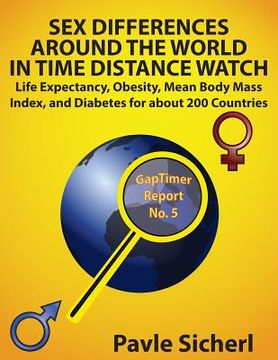Compartir
Sex Differences Around the World in Time Distance Watch: Life Expectancy, Obesity, Mean Body Mass Index, and Diabetes for about 200 Countries (en Inglés)
Pavle Sicherl
(Autor)
·
Createspace Independent Publishing Platform
· Tapa Blanda
Sex Differences Around the World in Time Distance Watch: Life Expectancy, Obesity, Mean Body Mass Index, and Diabetes for about 200 Countries (en Inglés) - Sicherl, Pavle
$ 80.601
$ 161.202
Ahorras: $ 80.601
Elige la lista en la que quieres agregar tu producto o crea una nueva lista
✓ Producto agregado correctamente a la lista de deseos.
Ir a Mis Listas
Origen: Estados Unidos
(Costos de importación incluídos en el precio)
Se enviará desde nuestra bodega entre el
Lunes 22 de Julio y el
Miércoles 31 de Julio.
Lo recibirás en cualquier lugar de Colombia entre 1 y 5 días hábiles luego del envío.
Reseña del libro "Sex Differences Around the World in Time Distance Watch: Life Expectancy, Obesity, Mean Body Mass Index, and Diabetes for about 200 Countries (en Inglés)"
This study offers new insights by analysing gender differences in life expectancy, mean body mass index, obesity and diabetes by using the novel time distance methodology. It combines two developments: firstly, recent availability of gender disaggregated longer time series by NCD Risk Factor Collaboration, 2016 on trends in body mass index and diabetes in 200 countries over 40 (35) years added to the UN long time series on life expectancy for about 60 years. As the focus we selected the gender difference in these indicators which can be attractive from both the medical and social standpoint and can be further elaborated with additional studies. Secondly, such longer time series make possible creative application of S-time-distance methodology for describing and analyzing indicator differences in the parallel dimension of time. Methodological innovations: parallel additional generic statistical measures S-time-distance, S-time-step and Level-Time Matrix as presentation and visualization tool. Expressed in time units they are comparable across variables, fields of concern and units of comparison. This makes S-time-distance an excellent complementary analytical and presentation tool offering additional insights, intuitive understanding, simplicity, and new semantics to many indicators and issues. In the gender difference for life expectancy one can address the question 'How many years ago did the current level of the male value reached the same level in the past trend for women?' to describe the gender differences in many indicators in the time distance dimension simultaneously with the static measures, leading to different perception of the extent of disparity than the conventional static measures alone. For life expectancy the time distance dimension of the diversion increases the perception of the degree of magnitude of sex difference in the indicator. In percentage terms in 2015 the range for 200 countries varied to about 15 percent for Belarus. The perception of the magnitude of sex differences is very different, as S-time-distances of women being ahead of men ranges up to about 60 years! in Belarus. Time lag for males behind the time when female life expectancy already achieved that level is on the world level about 14 years, about 38 years for more developed regions in UN definition and about 11 years for the less developed regions. USA and EU28 are both showing very substantial and persuading differences in favour of women, also at the regional NUTS levels in the EU and for the average of more than 3000 USA counties. The analysis of gender differences for the three more indicators, mean body mass index, obesity and diabetes, again shows that there were many cases where the time lead or time lag of one gender were larger than 20 years, which was taken as indication that such gender differences prevailed over longer periods of time (in either direction). For life expectancy and obesity about 100 countries show such female predominance. S-time-distance values range from more than 40 years of mean BMI values for males being ahead of mean BMI for females for Switzerland and Japan to more than 40 years of time lag in the opposite direction for five countries. Gender differences in obesity prevalence are strongly tilted in the female predominance. For Egypt, Turkey and South Africa the gender time distances show large time differences of 28, 24 and more than 40 years, respectively. For USA and for the UK the obesity prevalence is high also for men so that gender time distances are only few years. For diabetes there is predominance of cases for men in two high income regions; it was shown that for 26 countries (out of 27 countries) in the region High Income Western Countries the male values were for more than 20 years ahead of those for women. Time distances offer very different perception of the gender disparities as those of percentage differences at given point in time. We need both measures to understand the reality.

